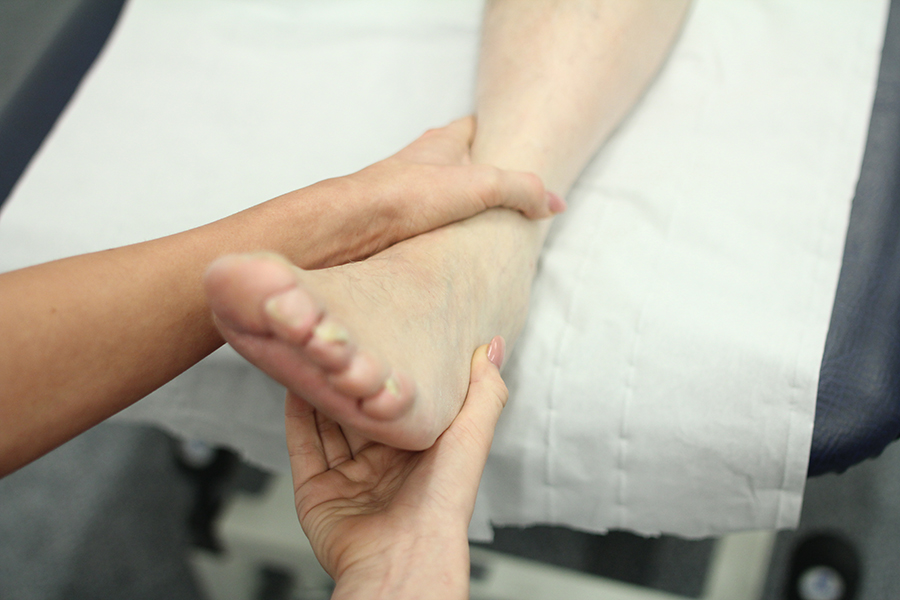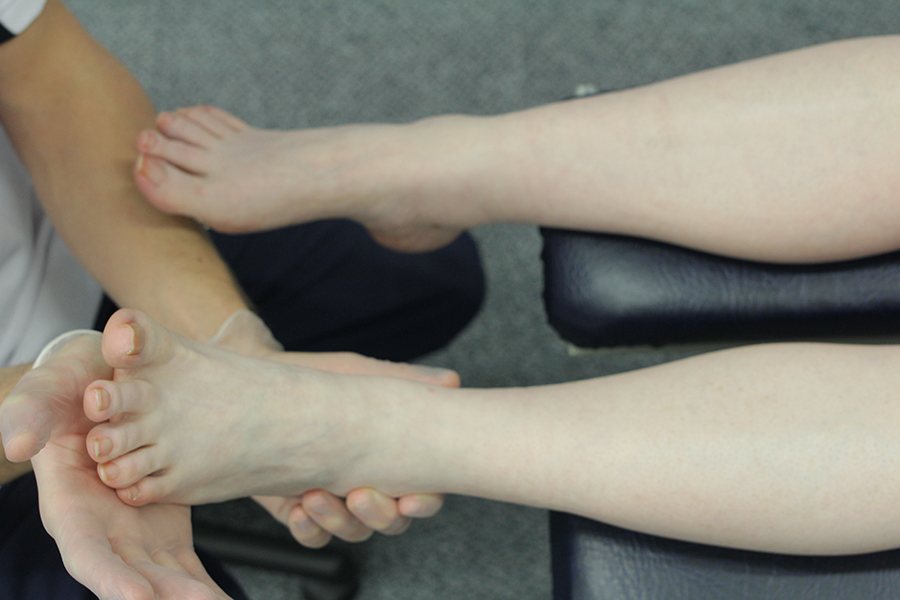Sesamoiditis
Sesamoiditis is a painful overuse injury that affects the sesamoid bones. The sesamoid bones are very small and sit within a tendon just behind the big toe.
If you think you have sesamoiditis you should visit a podiatrist. Your podiatrist will be able to distinguish sesamoiditis from other injuries associated with that same area and provide you with treatment and advice aimed and reducing your pain and discomfort.
Sesamoiditis is an overuse injury that is commonly observed in athletes, for example, cyclists and runners. However, anyone can get sesamoiditis, which is used to describe pain and inflammation associated with the sesamoid bones.
The sesamoids are unlike other bones in the body, this is because they are not part of a joint (not connected to another bone), and instead the sesamoids are suspended within a tendon. There are two sesamoids in the foot, these bones are very small and round, similar in size to a small pea. The sesamoids are positioned next to one another within the tendon of the muscle flexor hallucis brevis (a muscle that helps the big toe to flex), on the bottom of the foot, just behind the big toe on the 'ball'. This is called the head of the first metatarsal.
The sesamoids have an important job to do, they:
Sesamoiditis is typically an overuse injury that occurs due to the area being subjected to too much pressure. There are a number of reasons for this, for example:

The main sign of sesamoiditis is pain in the area on the sole of the foot just behind the big toe on the ball. The pain associated with sesamoiditis has been described as:
A podiatrist will be able to diagnose sesamoiditis based on a thorough history and an examination of the area.
If you have sesamoiditis there are many benefits that can be achieved following podiatric assessment and treatment at Chiropody.co.uk, and these include:
It is important to distinguish sesamoiditis from other conditions associated with the same area. The podiatrist will therefore obtain a thorough medical and social history, which along with an examination of the area will lead to a diagnosis. The podiatrist will then discuss with you the best treatment option/s for you, which may include:
A biomechanical assessment assesses the quality and range of movement of the joints in the foot and lower limb (knee and leg) both when standing and non-weight bearing, as well as an analysis of the way you walk (gait). The aim of the biomechanical assessment is to assess how the body is functioning, if it is not functioning as it should and this is producing pain the podiatrist can help to improve foot and lower limb function with orthoses.

Sesamoiditis is a painful overuse injury of the sesamoid bones. The sesamoid bones are two small round bones that sit within the tendon of a muscle called flexor halluces brevis, just behind the big toe on the bottom of the foot (also known as 'the ball').
The sesamoid bones have a number of functions and because of their position they can be subjected to a great amount of pressure, this can then lead to inflammation and pain. Sesamoiditis can affect anyone; however it is most often seen in athletes.
If you think you have sesamoiditis you should visit a podiatrist. A podiatrist is a specialist trained in the diagnosis management of conditions associated with the foot and lower limb. Your podiatrist will be able to provide advice and treatment that will help to alleviate the pain associated with sesamoiditis.
To arrange an assessment with one our podiatrists please email office@chiropody.co.uk or call 0330 088 4222.
If you think you have sesamoiditis you should visit a podiatrist. Your podiatrist will be able to distinguish sesamoiditis from other injuries associated with that same area and provide you with treatment and advice aimed and reducing your pain and discomfort.
What is sesamoiditis?
Sesamoiditis is an overuse injury that is commonly observed in athletes, for example, cyclists and runners. However, anyone can get sesamoiditis, which is used to describe pain and inflammation associated with the sesamoid bones.
The sesamoids are unlike other bones in the body, this is because they are not part of a joint (not connected to another bone), and instead the sesamoids are suspended within a tendon. There are two sesamoids in the foot, these bones are very small and round, similar in size to a small pea. The sesamoids are positioned next to one another within the tendon of the muscle flexor hallucis brevis (a muscle that helps the big toe to flex), on the bottom of the foot, just behind the big toe on the 'ball'. This is called the head of the first metatarsal.
The sesamoids have an important job to do, they:
- Work as pulleys that allow the tendon of flexor hallucis brevis to glide smoothly. The sesamoids therefore help to increase the efficiency of the muscle by increasing its mechanical advantage
- Lift the first metatarsal head off the ground, stabilising the joint as the heel lifts when walking
- Absorb the pressure produced when walking and standing. As a result the sesamoids are prone to damage due to the excessive loads and repetitive stress they experience
What causes sesamoiditis?
Sesamoiditis is typically an overuse injury that occurs due to the area being subjected to too much pressure. There are a number of reasons for this, for example:
- Increasing activity levels
- Wearing high heeled shoes
- High arched feet
- Bunions
- A plantarflexed first metatarsal (this means the metatarsal head is on a lower plane that the rest of the foot)
- Over-pronation
- Repetitive stress to the area

What are the signs and symptoms of sesamoiditis?
The main sign of sesamoiditis is pain in the area on the sole of the foot just behind the big toe on the ball. The pain associated with sesamoiditis has been described as:
- Like a bruise
- A dull ache
- Throbbing
- Walking on a pebble
How is sesamoiditis diagnosed?
A podiatrist will be able to diagnose sesamoiditis based on a thorough history and an examination of the area.
Benefits of podiatry for sesamoiditis
If you have sesamoiditis there are many benefits that can be achieved following podiatric assessment and treatment at Chiropody.co.uk, and these include:
- Reduced inflammation
- Reduced pain
- Improved function of the foot and lower limb
- Improved gait
- Reduced risk of future injury
What would podiatry for sesamoiditis involve?
It is important to distinguish sesamoiditis from other conditions associated with the same area. The podiatrist will therefore obtain a thorough medical and social history, which along with an examination of the area will lead to a diagnosis. The podiatrist will then discuss with you the best treatment option/s for you, which may include:
- Anti-inflammatory advice
- Rest
- Orthoses
- Footwear review
- Advice and education
- Padding
A biomechanical assessment assesses the quality and range of movement of the joints in the foot and lower limb (knee and leg) both when standing and non-weight bearing, as well as an analysis of the way you walk (gait). The aim of the biomechanical assessment is to assess how the body is functioning, if it is not functioning as it should and this is producing pain the podiatrist can help to improve foot and lower limb function with orthoses.

Summary
Sesamoiditis is a painful overuse injury of the sesamoid bones. The sesamoid bones are two small round bones that sit within the tendon of a muscle called flexor halluces brevis, just behind the big toe on the bottom of the foot (also known as 'the ball').
The sesamoid bones have a number of functions and because of their position they can be subjected to a great amount of pressure, this can then lead to inflammation and pain. Sesamoiditis can affect anyone; however it is most often seen in athletes.
If you think you have sesamoiditis you should visit a podiatrist. A podiatrist is a specialist trained in the diagnosis management of conditions associated with the foot and lower limb. Your podiatrist will be able to provide advice and treatment that will help to alleviate the pain associated with sesamoiditis.
To arrange an assessment with one our podiatrists please email office@chiropody.co.uk or call 0330 088 4222.
Save 5% by booking an appointment online.

Find your nearest clinic
We have clinics located throughout the North West. We also provide a home visit service.
Find out more »

No waiting lists!
Tired of waiting for treatment? Be seen by a podiatrist today!
Find out more »

Not sure how we can help?
Speak to a podiatrist to find out how we can help. Call us on 0330 088 4222.
Find out more »
We work with:

Individuals

Organisations

Health professionals
Get in Touch!
0330 088 4222
If you would like to speak to one of our specialists then please complete this form.
We are open 7 days a week








